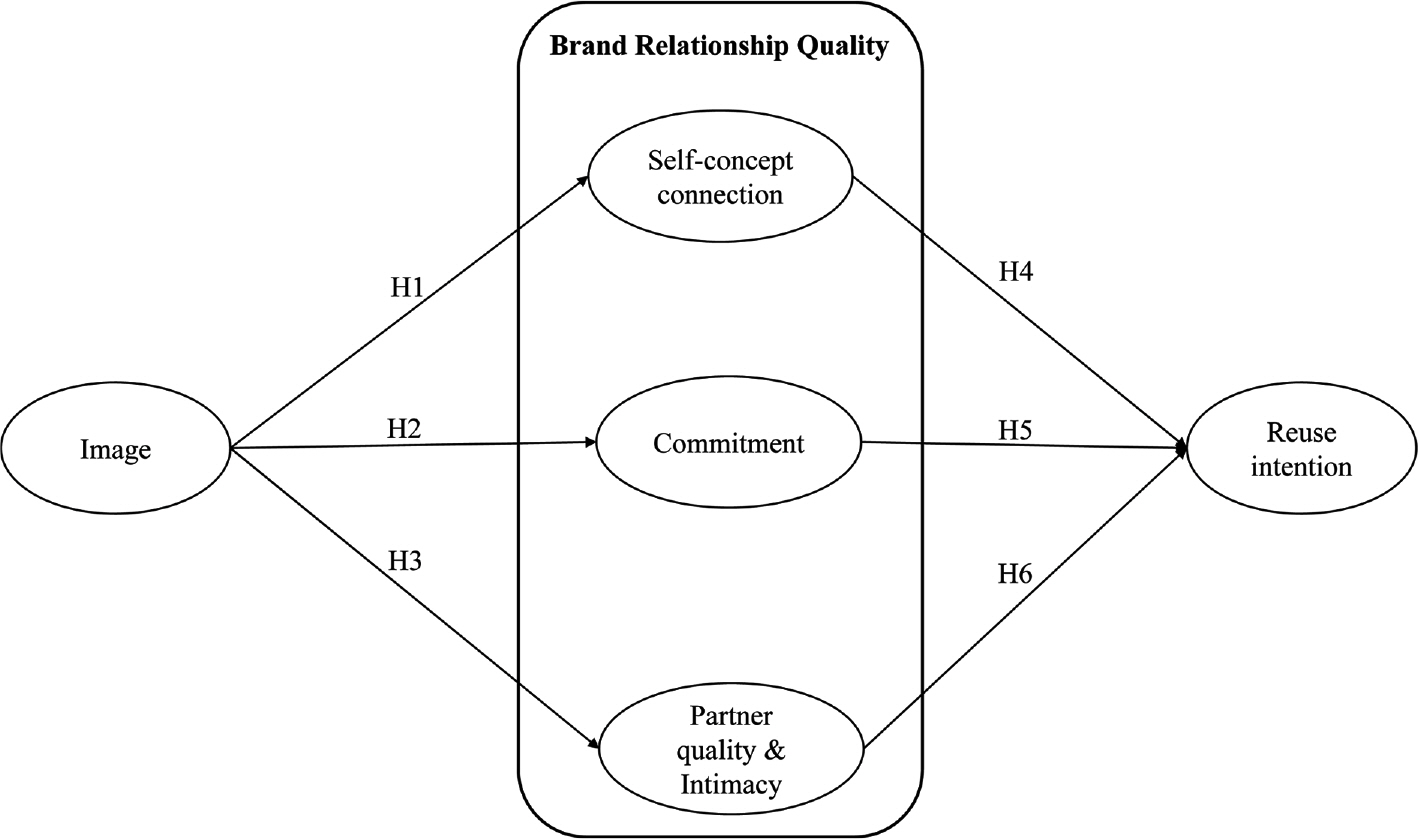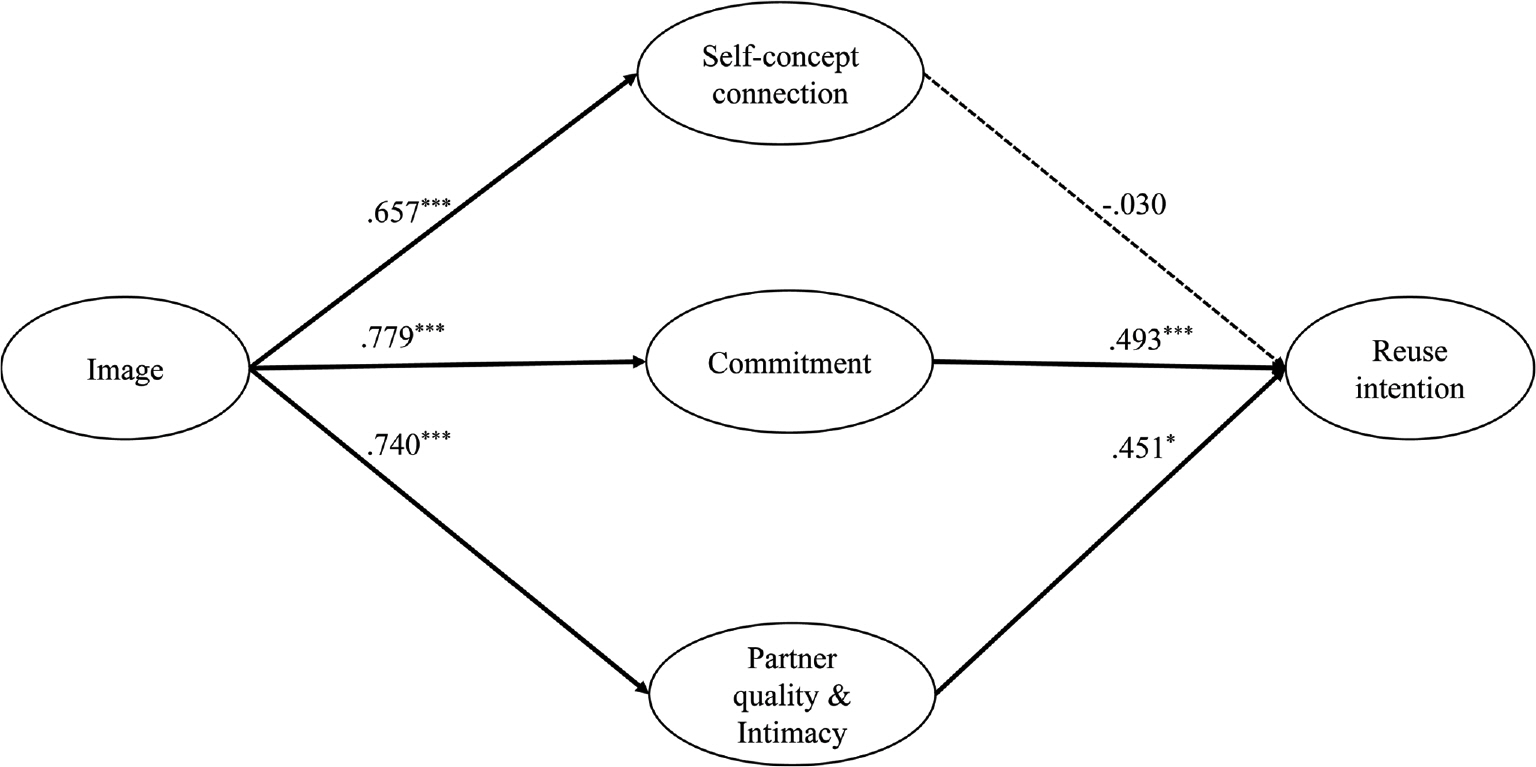J Nutr Health.
2017 Jun;50(3):302-311. 10.4163/jnh.2017.50.3.302.
Effects of brand image on brand relationship quality and reuse intentions in baby food
- Affiliations
-
- 1Industry-Academic Cooperation Foundation, Kookmin University, Seoul 02707, Korea.
- 2Department of Food and Nutrition, Kookmin University, Seoul 02707, Korea. malee@kookmin.ac.kr
- KMID: 2386631
- DOI: http://doi.org/10.4163/jnh.2017.50.3.302
Abstract
- PURPOSE
The aim of this study was to determine the effects of brand image of baby food on brand relationship quality and reuse intentions.
METHODS
A total of 211 questionnaires completed by customers who bought Brand B baby food were obtained from empirical research. SPSS 22.0 and AMOS 23.0 were employed for statistical analysis.
RESULTS
Customers perceived Brand B baby food as "Convenient", "Professional", "Reliable", "Famous", and "Healthy". Overall, the results indicate that perceived image for Brand B baby food had a significantly positive effect on brand relationship quality in terms of self-concept connection, commitment, and partner quality and intimacy. In addition, commitment and partner quality and intimacy had significantly positive effects on reuse intentions for Brand B baby food.
CONCLUSION
The results of this study reveal the importance of brand image in baby food to improve brand relationship quality in terms of commitment and partner quality and intimacy as well as reuse intentions. Therefore, it is necessary to recognize positive brand image as a key factor in forming relationships between consumers and brands as well as search for ways to apply marketing strategies based on brand image.
MeSH Terms
Figure
Reference
-
References
1. Jeon MH, Cho JK. A case study of gold kids service marketing for domestic hotels. J Product Res. 2015; 33(3):59–68.2. Korean Statistical Information Service. 2015 population and housing census [Internet]. Daejeon: Statistics Korea;2016. [cited 2017 Mar 17]. Available from:. http://kosis.kr.3. Statistics Korea. 2016 women's life in statistics [Internet]. Daejeon: Statistics Korea;2016. [cited 2017 Mar 17]. Available from:. http://kostat.go.kr.4. Korea Agro-Fisheries & Food Trade Corporation. 2015 processed food segment market status: infant formula market [Internet]. Naju: Korea Agro-Fisheries & Food Trade Corporation;2016. [cited 2017 Mar 17]. Available from:. http://www.atfis.or.kr.5. Ministry of Food and Drug Safety (KR). Food and food additive production performance [Internet]. Cheongju: Ministry of Food and Drug Safety;2016. [cited 2017 Mar 17]. Available from:. http://www.mfds.go.kr.6. Korean Statistical Information Service. Mining and manufacturing survey/item number classifieds businesses [Internet]. Daejeon: Statistics Korea;2014. [cited 2017 Mar 17]. Available from:. http://kosis.kr.7. Bebecook (KR). Production stage for baby food [Internet]. Seoul: Bebecook;; [cited 2017 Apr 5]. Available from:. http://www.bebecook.com.8. Kim YK, Hur W. Dimensions of brand relationship quality (BRQ): focusing on the influence of product categories & communication factors. Korean J Journal Commun Stud. 2003; 47(4):190–219.9. Blackston M. Beyond brand personality: building brand relationships. Aaker DA, Biel AL, editors. editors.Brand Equity and Advertising: Advertising's Role in Building Strong Brands. Hillsdale (NJ): Erlbaum;1993. p. 113–124.10. Cho HM. The influence of congruence between brand personality and parental self image on brand relationship quality. Korean Bus Educ Assoc. 2006; 9:85–113.11. American Marketing Association. Dictionary [Internet]. Chicago (IL): American Marketing Association;c1995. [cited 2017 Mar 17]. Available from:. https://www.ama.org/resources/Pages/Dictionary.aspx?dLetter=B.12. de Chernatony L, Dall'Olmo Riley F. Defining a "brand": beyond the literature with experts' interpretations. J Marketing Manag. 1998; 14(5):417–443.
Article13. Kim DK, Koh IK. A study on the influence of brand image and product attributes upon purchase intention: focusing on the analysis of full-sized sedan. Korean Corp Manage Rev. 2010; 17(4):215–231.14. Fournier S. A consumer-brand relationship framework for strategic brand management [dissertation]. Gainesville (FL): University of Florida;1994.15. Fournier S. Consumers and their brands: developing relationship theory in consumer research. J Consum Res. 1998; 24(4):343–373.
Article16. Kim BJ, Kang MS, Cho HH. A study on the form of consumer-brand community relationship. J Aviat Manag Soc Korea. 2007; 5(2):187–202.17. Kim YK. Dimensions of consumer-brand relationships. Advert Res. 2002; 54:7–32.18. Choi MW, Cho BL. A study of the brand relationship quality: with focus on the relation with the components of brand equity. Korean J Advert Public Relat. 2005; 7(4):127–168.19. Kim KH, Park JW, Kim JK. Consumer–brand relationship quality: when and how it helps brand extensions. J Bus Res. 2014; 67(4):591–597.
Article20. Park JW, Kim KH, Kim JK. Acceptance of brand extensions: interactive influences of product category similarity, typicality of claimed benefits, and brand relationship quality. Adv Consum Res. 2002; 29(1):190–198.21. Smit EG, Bronner F, Tolboom M. Brand relationship quality and its value for personal contact. J Bus Res. 2007; 60(6):627–633.
Article22. Xie D, Heung VC. The effects of brand relationship quality on responses to service failure of hotel consumers. Int J Hosp Manag. 2012; 31(3):735–744.
Article23. Kim M, Seo KH, Lee SB. A study on the structural relationships among brand personality, customer-brand relationship quality, and repurchase intention: focusing on domestic pizza market. Culin Sci Hosp Res. 2013; 19(2):130–148.24. Lee YJ, Kim YK, Han KS, Choi DJ. A study on the effect of brand recognition on brand personality, brand image and customer-brand relationship quality in the university contract foodservice industry. Culin Sci Hosp Res. 2011; 17(2):51–73.25. Kim HA. Effect of the consumer-brand relationship quality on the brand loyalty in the fast food restaurant in Masan, Korea. J Korean Soc Food Sci Nutr. 2005; 34(4):489–495.26. Kim HA. Effect of the consumer-brand relationship quality on the revisit intent and recommendation intent in the family restaurant in Masan, Korea. Korean J Food Cult. 2006; 21(4):396–405.27. Ryu GS, Jang JM, Lee HK. The impact of CRM programs on word-of-mouth behavior: the mediating role of consumer-brand relationship quality. J Consum Stud. 2004; 15(3):87–109.28. Park SH, Kim TH, Kim JS. A study on the impacts of hotel restaurant brand personality on the quality of the customer-brand relationship and revisits. Korean J Hosp Adm. 2005; 14(4):99–115.29. Park SH, Kim TH, Lee SB. A study of the impact of family restaurant brand personality on the quality customers-brand relationship and revisits. J Foodserv Manage. 2006; 9(2):47–66.30. Park YB, Ahn DH, Lee SW. A study on the effect of brand personality, relationship quality on the customer satisfaction, loyalty in the foodservice industry. J Foodserv Manage. 2009; 12(5):187–204.31. Kim JY, Lee KH. Brand images of children's wear and mother's purchase intention: focus on self-image congruence and behavioral intention model. Res J Costume Cult. 2011; 19(3):622–636.32. Cho HM, Song KS. A study on the influence of congruity between brand personality and parental self image on satisfaction in the prestige brand market of infant apparels. Consumption Cult Study. 2007; 10(1):29–48.33. Oliver RL. Satisfaction: abehavioral perspective on the consumer. 2nd ed.New York (NY): Routledge;2015.34. Schumacker RE, Lomax RG. A beginner's guide to structural equation modeling. 2nd ed.Mahwah (NJ): Erlbaum;2004.35. Hair JF. Multivariate data analysis: aglobal perspective. 7th ed.Upper Saddle River (NJ): Prentice Hall;2010.36. Nunnally JC. Psychometric theory. New York (NY): McGraw-Hill;1967.37. Fornell C, Larcker DF. Structural equation models with unobservable variables and measurement error: algebra and statistics. J Mark Res. 1981; 18(3):382–388.
Article38. Kim JG, Kim JH, Kim HG. The effect of product innovativeness on brand relationship quality and purchase intention. Logos Manag Rev. 2015; 13(3):37–56.
- Full Text Links
- Actions
-
Cited
- CITED
-
- Close
- Share
- Similar articles
-
- Causal-effect Analysis of Brand Equity Factors in Contract Foodservice Management Company in College and University in Incheon Area
- Influence of the Consumer-Brand Relationship Quality on the Customer Satisfaction in the Family Restaurant
- A study on the Determinants Affecting Consumer's Perception on Consumer-Brand Relationship Quality in the Fast Food Restaurant
- A Study on Brand Personality and Employee's Self: Image Congruity and Job Satisfaction: Especially for Family Restaurant
- Scale Development for Measuring the Brand Images of Contract Foodservice Management Companies



